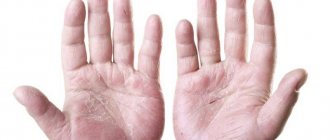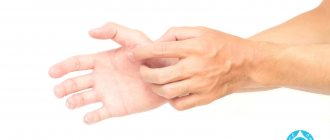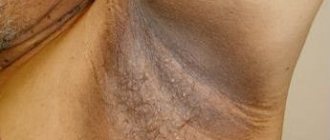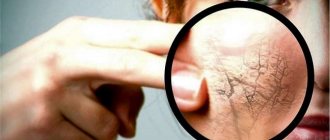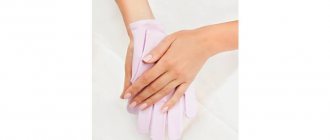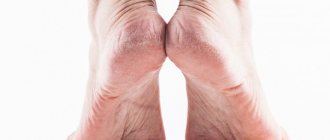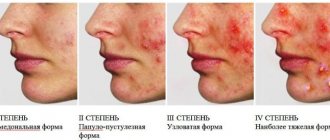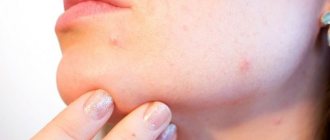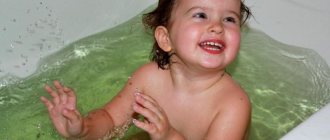Anyone who has experienced the discomfort of dry, flaky skin wants a quick fix. In this article, you will learn about the causes of dry facial skin and how to get rid of it.
People can experience dry skin on their face as a result of many factors, including changes in temperature or humidity, using soaps with harsh chemicals, and skin conditions.
In most cases, people can get rid of dry skin using home remedies and beauty treatments.
Skin types and their differences
Everyone knows that there are three main skin types - oily, normal and dry. Each of them has its own advantages and disadvantages: at a certain period of life, skin can both please and sadden its owner.
One of the most striking criteria by which dry skin can be distinguished from normal skin is a frequent feeling of tightness, which appears especially clearly after washing even with plain water, not to mention washing with cleansing products (soap, makeup remover milk, etc.) . The second criterion is a fine-porous structure (while in oily and normal skin the pores are often noticeable or even enlarged, then in dry skin they are not visible).
You may be interested in: Facial taping: reviews, description of the procedure, results
At a young age, those with dry skin are happy: it is problem-free, people with this skin type do not have acne or pimples. However, already from the age of 27-28, facial wrinkles begin to form on dry skin. Those with normal skin usually develop facial wrinkles by the age of 34-36. Dry skin is more prone to early aging and wrinkles, especially if it is not moisturized and cared for properly.
How to distinguish dry skin from normal skin
It is very easy to distinguish dry skin from normal skin; just do a simple test. If, when pressing on the surface of the face, fingerprints do not disappear immediately, then the skin is dry.
Why can skin be normal in youth, but become dry with age? This can happen due to a violation of lipid (fat) and water metabolism, disruption of the functioning of the sebaceous glands in the epidermis, and a violation of the acid-base state of the skin surface. If the skin on your face and hands, as well as other parts of the body, dries and peels, you should get tested for hormone balance. Dry and itchy skin over a large area of the body can be a sign of serious health problems.
Seasonal care for dry skin
Skin care depends not only on age and gender, but also on the time of year. For dry skin, the most unfavorable seasons are winter and summer; it is during these periods that the most frequent exposure to ultraviolet radiation, wind, dry air, and snow occurs.
In winter. It is necessary to use fatty nourishing creams and masks. Anti-frost and wind creams are applied to the face. You need to be on the street as little and as little time as possible. Do not warm your face with hot water or intense rubbing.
Important! During this period, moisturizers are applied at least 30 minutes before going outside.
In the spring. The most favorable time for those with dry skin. During this period, the skin stops drying and flaking. At this time, you need to prepare your skin for the summer season - nourish it with moisture. Renewal can be carried out using peelings, light polishing, skin restoration is carried out through mesotherapy.
At home, light scrubs and intense nourishing masks are used.
In autumn. During the transition period between summer and winter, it is necessary to restore the skin after ultraviolet radiation and prepare it for unfavorable winter conditions.
For this, restorative masks, light milk peels, and injection techniques are used.
In summer. During the hot season, you should not use fatty creams or oils; they are replaced with light moisturizers. For dry skin, a gel base is suitable.
Moisturizing masks are applied every other day. And during the day, you can use portable ultrasonic humidifiers, which can be purchased at beauty supply stores.
Regardless of the weather, it is necessary to use sunscreen; in city conditions, preparations with SPF 25-30 are suitable; when going on vacation, the level of protection should be 50 or higher.
Why does our skin need water?
You may be interested in: Wrinkle filler: overview of types, application, effectiveness, reviews
For a decent appearance of the skin, a sufficient level of hydration is necessary, that is, full of moisture. This parameter largely depends on nutrition and lifestyle. And if it is insufficient, then the skin of the face and body becomes painfully dry and peeling appears. Some dermatologists argue that the earlier appearance of rosacea is characteristic of dry skin. With insufficient and irregular hydration, the skin becomes thin, dry, easily injured, and the first expression wrinkles appear.
The degree of skin hydration from the inside depends on two factors that affect moisture exchange with the environment. This is the amount of sebum produced and the condition of the stratum corneum of the epidermis. They not only support the protective functions of the skin, but are also responsible for maintaining normal levels of moisture retention in cells. These two factors are closely related to lifestyle, health status, presence of chronic diseases, etc.
Skin xerosis: a problem of dermatology
A recent survey of more than 4,500 people over 15 years of age in 8 EU countries showed that ~40% of them have sensitive skin, which most often manifests itself as dry skin. The majority of these individuals indicated the presence of atopic dermatitis (AD) in childhood. According to Japanese researchers who studied the prevalence of AD over the period 1998–2004, sensitization to inhalant allergens can be easily established in children with clinically severe dry skin, in the absence of other symptoms of AD itself.
Dry skin is a cardinal sign not only of blood pressure. Sometimes practically healthy people complain about dry skin, in whom improper skin care (chemical exposure as a result of frequent use, in particular, soap and shower gel, other cosmetics, detergents) leads to dry skin. Climatic features of the environment (temperature and humidity, strong winds, prolonged exposure to sunlight, etc.), especially in combination with a congenital predisposition to increased dry skin, can also cause xeroderma. Other external causes include aggressive environmental factors (tobacco smoke, air pollutants), time zone changes, incorrectly selected cosmetic care products, as well as sleep and nutritional disturbances.
More than 75% of people over 70 years of age have dry skin, which is the main cause of itchy skin on the lower extremities in older people. Xeroderma, as a rule, accompanies hypothyroidism and intestinal malabsorption. Increased dryness of the skin is detected in patients with cancer, hematological diseases, hypovitaminosis, hepatitis, cirrhosis and chronic renal failure.
Dry skin is the main symptom of most dermatological diseases. Thus, it is present in almost 100% of patients with AD. Congenital dry skin is observed in patients with psoriasis, seborrheic dermatitis, ichthyosis, keratosis pilaris, irritant eczema of the hands, etc.
This skin condition is characterized by a feeling of discomfort; dry skin is often accompanied by itching, burning, tingling, peeling, and hyperemia. All this leads to a decrease in the patient’s quality of life and, along with specific treatment of the underlying disease, requires proper care of dry skin using various emollients and moisturizers.
Let us briefly describe the characteristics of dry skin.
What is dry skin and how does it differ from normal skin?
The skin is the first to react to environmental influences. As you know, the skin has three main layers: an outer layer (epidermis) and two inner layers (dermis and subcutaneous fat). The ducts of the sebaceous and sweat glands extend to the surface of the skin, supplying the skin with moisture and lipids. The epidermis is divided into 5 levels, of which the uppermost is the horny layer. The main cells found in the epidermis are keratinocytes and melanocytes. In turn, the stratum corneum is formed from corneocytes (which contain lipids) and water. The majority of lipids in the stratum corneum are ceramides (50%), fatty acids (10–20%) and cholesterol (25%). The corneocytes themselves contain the so-called natural moisturizing factor (NMF). What is his role? It is known that the stratum corneum normally contains 15–13% water. When the water content decreases to 10% or below, visible scales form in the skin and it becomes dry. To prevent this process, the epidermis contains moisturizing substances, the main of which is EUV - a component consisting of a mixture of amino acids, their derivatives, as well as minerals formed during the hydrolysis of filaggrin protein. These water-soluble compounds are hygroscopic, meaning they retain water. Such water acts as an intracellular adhesive substance in the stratum corneum, thereby the corneocytes retain their elasticity and prevent desquamation and the formation of cracks in damaged skin. There are three forms of water in the skin: static, or “bound”, dynamic and transepidermal. Transepidermal water is formed from circulating blood, it penetrates through the dermis into the epidermis and ultimately evaporates from the surface of the skin. This movement of water plays a role in the nutrition of the epidermis, which, as is known, does not contain blood vessels. Static water of the stratum corneum is localized between the lipid layers and inside the corneocytes. The stratum corneum also contains other moisturizing components (hyaluronic acid, glycerol, lactate), which mainly play a role in maintaining the physical properties of the epithelial skin barrier.
Another important protective mechanism of the skin is an acidic reaction on its surface, which protects the skin from penetration of microorganisms, regulates the hydration process, maintains the natural state of the epidermis and determines the difference in biological skin types. Skin pH is directly related to the level of dynamic water in the stratum corneum. The pH of healthy skin of newborns ranges from 6.5–7.0, which requires specially selected hygiene products in accordance with age. With dry skin, it is very difficult to maintain a normal pH level. A change in its level contributes to the deterioration of lipid metabolism in the skin, as well as its infection.
The epidermis, together with the hydrolipid film, forms the so-called barrier function: protecting the skin from environmental factors, mechanical damage and increased water loss. From the above it follows that with dry skin all these processes are disrupted. Moreover, recently scientists consider defects in the barrier function of the skin to be one of the main reasons for the development of AD in particular. This is convincingly evidenced by data such as an increase in transepidermal water loss, a decrease in the threshold of skin susceptibility to external irritants and pathogens, as well as skin dryness. In addition, as immunohistochemical studies of atopic skin show, the severity of barrier function impairment correlates with the degree of the inflammatory process in AD and, in general, with the severity of the disease [1, 2]. It has also been proven that skin barrier dysfunction is significantly influenced by an imbalance between the level of proteases (chemotryptic, tryptase, cysteine protease) and their inhibitors, as well as staphylococcal superantigens.
Recently, a deficiency of antimicrobial peptides—a kind of endogenous antibiotics—has been given an important role in the disruption of skin barrier function. More than 20 different antimicrobial proteins have been characterized. The two most studied groups are cathelicidins (in particular, LL-37) and beta-defensins, which exhibit synergistic antimicrobial activity against staphylococcus and Malassezia furfur fungi. In healthy skin, these peptides are expressed in very low quantities, but can accumulate in the skin during inflammation [3].
A number of authors associate skin barrier dysfunction with genetic features of the skin structure, in particular, with a mutation of the filaggrin gene, a specific gene responsible for the so-called epidermal differentiation complex [3, 4]. Scientists see increased susceptibility to skin infections in AD not only in defects in the epithelial barrier, but also in the expression of Th2 lymphocyte cytokine receptors. However, what is primary in these processes - a defect in the barrier function of the skin or inflammation - is still not clear. Restoration of the skin barrier function is also associated with the reconstruction of the lipid-enriched intracellular substance of the stratum corneum. This process consists of two phases: an initiating fast phase and a late prolonged phase, which includes, in particular, the synthesis of new lipids in corneocytes (ceramides, cholesterol, fatty acids) with the help of a number of transcription factors and proteins.
What does dry skin affect? It was said above that in the presence of xerosis, the skin’s susceptibility to exposure to surrounding allergens, irritants, as well as bacteria and viruses increases significantly. The close relationship between the xerosis-itch cycle should also be taken into account. Accordingly, effective treatment of dry and itchy skin may improve treatment outcomes for AD. However, it is impossible to simply influence the causes of dry skin, such as changes in the stratum corneum, disturbances in keratinization, the composition of the balance of intracellular lipids, transepidermal water metabolism, changes in skin pH, etc., by simply applying moisturizers and/or emollients to the skin. These are very complex physicochemical, biochemical and pathophysiological processes that occur differently in skin diseases. Recently, scientists have been considering dry skin in atopy from the point of view of a single pathophysiological concept “atopy, dry skin and the environment”.
Main factors affecting dry skin
In summary, specific mechanisms that impair skin barrier function include factors such as deficiency of ceramide synthesis and decreased levels of (EUV) in the stratum corneum. Perhaps, in the future, this leads to impaired differentiation of the epidermis, which is manifested by defects in the barrier function of the skin, an imbalance in lipid biosynthesis, etc. Repeated exposure to damaging factors enhances the immune inflammatory process, even involving the endothelium, impaired keratinization, etc. [4] .
The main external triggers that maintain dry skin are temperature, humidity, sun rays, as well as chemical agents: soap, shower gel, alcohol solutions, detergents. We should not forget about pharmacotherapy using retinoids, alcohol-containing solutions, and phototherapy. In addition, with dry skin, not only does the absorption of topical corticosteroids significantly increase (hence their side effects), but their prolonged use leads to dryness and atrophy of the skin itself.
The features of dry skin briefly described above in fact, of course, represent more complex physico-biochemical, immunological and biological processes that scientists continue to study around the world. One of the important tasks remains to elucidate the exact immunopathophysiological and etiological mechanisms of the development of such chronic skin diseases as psoriasis and AD.
Treatment for dry skin
Dry skin is a systemic process. Therefore, such general recommendations as adequate drinking, eating a balanced diet enriched with fruits and vegetables, stopping smoking and drinking alcohol, avoiding prolonged exposure to the sun, regular exercise, and using special hygiene products for dry skin are very relevant in all cases of xeroderma.
On the other hand, it is clear that moisturizers and emollients applied to dry skin should, in fact, be similar in composition and concentration to the physiological lipids of healthy skin.
Scientific data in recent years have made it possible to substantiate the absolute importance of external therapy for all skin diseases accompanied by xerosis. First of all, this affected new therapeutic options for AD, which led to the development of a new direction in medicine - the pharmaceutical and cosmetic industry. Therapeutic moisturizers/softeners had to meet criteria such as age group, effectiveness for dry skin of various origins, high safety profile, excellent tolerability, hypoallergenicity, and compliance with international development and production standards.
Let's consider some features of the modern approach to the treatment of AD, one of the main types of which scientists unanimously recognize the need for external auxiliary therapy - skin hydration and the use of emollients.
Moisturizers/emollients: are they really effective for blood pressure?
It is known that a significant decrease in the level of ceramides, the main molecules that retain water in the stratum corneum, was found in both affected and unaffected skin of patients with AD; in all patients with AD, the pH of the skin is changed, etc. Violation of the barrier function of the skin occurs in both types of AD - allergic and non-allergic, but scientists believe that it is more pronounced in the non-allergic form. It has also been proven that with AD the skin is dry even without an exacerbation of the disease. In this regard, the use of moisturizing/softening agents is justified during those periods of the disease when there are no symptoms [1–3]. However, we should not forget about the likelihood of side effects from these drugs too.
Let's conduct a short review to evaluate the effectiveness of moisturizers/emollients for blood pressure.
Analysis of published reports shows that the effectiveness of moisturizers/emollients depends on the dose (they should be used regularly and in sufficient quantities), skin pH, and patient compliance. It is especially important to use moisturizers/emollients in combination with anti-inflammatory drugs (topical corticosteroids, topical calcineurin inhibitors). This approach is superior in reducing all symptoms of blood pressure and is more effective than monotherapy with anti-inflammatory drugs alone. Thus, in children and adults suffering from mild to moderate AD, Hanifin et al. conducted a comparative study of the effectiveness of topical application of moisturizing cream 3 times a day in combination with a topical corticosteroid 2 times a day (group 1) and monotherapy with a hormonal drug (group 2) [5]. After 3 weeks of treatment, significant clinical improvement was achieved in the first group of patients compared to the second group. In addition, more than 95% of study participants expressed a desire to receive combination therapy. In another study, an emollient cream was added to 2.5% hydrocortisone cream administered once daily; This treatment regimen was compared with the effectiveness of twice using only one hormonal drug [6]. It has been shown that the addition of an emollient reduces the need for topical hormone, and its regular use helps prevent further exacerbations of blood pressure.
The effectiveness of auxiliary drugs was clinically and morphologically confirmed in a study by Chamlin et al., who added an emollient with a predominance of ceramides to the standard therapy of a group of children with “persistent resistant blood pressure” [7]. By the end of 6–12 weeks, all patients showed clinical improvement in blood pressure. In addition, extracellular laminar membranes were found in the ultrastructure of the stratum corneum, which were almost completely absent initially.
An interesting study was conducted back in 1998 by Ainley-Walker et al., who studied the effectiveness of various external agents in patients with AD by applying them to two symmetrical areas of the affected skin [8]. The study included 82 patients (66 of them children) who used a moderate/high potency topical corticosteroid and emollients. When comparing the effectiveness of a topical mild class hormone and an emollient, the hormonal drug was effective in 10 cases out of 17, in 5 cases the clinical effectiveness of the drugs was the same, and in two cases the emollient was even more effective than the hormone.
Without age restrictions, the Nizhi laboratory has developed the Topicrem line for patients with AD, psoriasis, and seborrheic dermatitis.
Another French program for the treatment and care of dry atopic skin has proven itself to be excellent for all age groups. This is a whole line of medicinal cosmetics created on the basis of thermal waters. Uryazh thermal water differs from other mineral waters in its isotonicity, i.e. its osmotic pressure is close to the osmotic pressure of blood plasma and cells, therefore Uryazh water does not violate the integrity of cells and does not change their volume. Thanks to the minerals and trace elements it contains, Uriage water has moisturizing, soothing and protective (with regard to lipid oxidation) effects. Currently, products based on Uriage thermal water have been developed, including for dry atopic skin: Cu-Zn cleansing liquid gel (containing no soap or fragrance), Cu-Zn cream, Uriage Emolyant Extrem (Emolyant form - “water in oil” ). Uriage Emolyant Extrem is prescribed for severe dry skin of the face and body in children and adults. It consists of raspberry seed oil, oligosaccharides, Uriage thermal water 30%, plant squalane and sterol. The drug is applied 2 times or as needed. As a result of using Emolyant Extrema, the barrier function of the skin and its level of hydration are restored.
Hydrolipidic, as an “oil in water” form, is intended primarily for daily care of very dry and sensitive skin, including senile skin. The essential fatty acids included in the emulsion help compensate for lipid deficiency and enhance the adhesion of epidermal cells. For severely dry skin, accompanied by desquamation and/or hyperkeratosis, after cleansing the skin, apply Keratosan - it has an “oil in water” milk texture and is easily applied to large areas of the body 2 times a day. The emulsion is easily absorbed without leaving a greasy residue. After the first applications, a very slight and quickly passing tingling sensation may be felt.
The latest development from Uriage laboratories is the Cerasterol-2F complex, which is integrated into the structure of the skin barrier, restoring it. Based on this complex, Xemoz Uriage cream was created to intensively moisturize dry skin in newborns, children and adults with all types of xerosis. Xemoz also contains phytosqualane, glycerin, shea butter, Uriage thermal water 30%; Apply 1-2 times a day or more often as needed.
Thus, the basic rules for caring for atopic skin include daily cleansing of the skin by taking a shower using a special cream (soap-free soap) for washing (Uriage Cleansing Dermatological Gel; Mustela Stelatopia Wash Cream, etc.); almost immediately after blotting the skin, the patient is recommended to apply a moisturizer, which the doctor prescribes to the patient depending on the condition of his skin. In particular, hydrating creams are used to moisturize the skin of the face; on the limbs and fold area - lipid-enriched ointments; for exacerbation of blood pressure - cream, emulsion; in remission - lipid-enriched ointments; in summer - hydrating creams; in winter - lipid-enriched ointments. Only after proper skin care does the doctor recommend that the patient apply an anti-inflammatory drug to the skin, depending on the severity of the skin disease accompanied by the symptom of dry skin.
Literature
- Elias PM Stratum corneum defensive functions: an integrated view // J Invest Dermatol. 2005; 125:183–200.
- Morar N., Cookson WO, Harper JI, Moffatt MF Filaggrin mutations in children with severe atopic dermatitis // J Invest Dermatol. 2007; 127:1667–72.
- Bieber T. Atopic Dermatitis // NEJM, 2008; 358:1483–1494.
- Barcoa D., Gimenez-Arnaub Xerosis A. A dysfunction of the epidermal barrier // Actas Dermosifiliogr. 2008; 99:671–682
- Hanifin J., Hebert A., Mays S. Effects of a low-potency corticosteroid lotion plus a moisturizing regimen in the treatment of atopic dermatitis // Curr Ther Res. 1998; 59: 227–233.
- Imokawa G., Abe A., Jin K. et al. Decreased level of ceramides in strarum corneum of atopic dermatitis: an etiologic factor in atopic dry skin? // J Allergy Clin Immunol. 1999; 104:S123–S125.
- Chamlin S., Kao J., Frieden L. et al. Ceramide-dominant barrier repair lipids alleviate childhood atopic dermatitis: changes in barrier function provide a sensitive indicator of disease activity // J Am Acad Dermatol. 2002; 47: 198–208.
- Ainley-Walker P., Patel L., David T. Side to side comparison of topical treatment in atopic dermatitis // Arch Dis Child. 1998; 79: 149–152.
D. Sh. Macharadze , Doctor of Medical Sciences, Professor
RUDN University , Moscow
Common Causes of Dry Skin
Often women turn to cosmetologists and dermatologists with complaints that the skin on their face is dry. The causes of this pathology are as follows:
- Exposure to sunlight (ultraviolet radiation) is detrimental to the upper and deep layers of the epidermis and is almost guaranteed to lead to subsequent dryness of the skin on both the face and body.
- Frost and wind in winter and autumn also lead to deterioration of the skin and its dehydration. Why does the skin on the face peel in winter and what to do in this case? The fact is that inside each pore its own moisture freezes - hence the peeling. Moreover, you should not use moisturizers before going out into the cold. This causes the skin on your face to dry out even more.
- Central heating in apartments and offices, as well as running radiators, make the air dry, resulting in a feeling of tightness and flaking. If the skin on your face dries out, you should ventilate the room and stop using radiators.
- Unfavorable ecology - exhaust gases and industrial poisons in the air negatively affect the condition of the epidermis.
- Improper skin care, abuse of acid peels, use of overly aggressive compositions when washing, use of lotions and tonics containing alcohol.
- Bad habits: alcohol abuse and smoking cause blood vessels to deteriorate, and the skin becomes fragile, thin and lean.
- Hormonal imbalances and some chronic diseases can cause skin problems on the face.
- Hot baths, frequent stays in saunas and steam baths can also contribute to the appearance of characteristic symptoms.
You may be interested in:Skin care after peeling: features of the procedure, skin reaction and recovery
The reasons why the skin on your face dries out may vary depending on your lifestyle and individual health characteristics. If, for example, the reason is a hormonal imbalance, then traditional methods of treatment and even pharmaceutical products may be powerless.
Dry skin on the face in men
Despite the popular belief of many, it is necessary to take care of men's skin, especially if it is dry or dehydrated.
In men, physiologically dry skin is rare; usually due to improper care or exposure to environmental factors, the lipid barrier is destroyed and the skin loses internal water.
To avoid negative consequences, you must adhere to a number of simple rules:
- Before shaving, apply a thin layer of moisturizer to the skin;
- to shave your beard and mustache, it is better to use shaving cream or gel rather than soap;
- after shaving you need to use milk, lotion or cream; in winter you can use fatty products;
- Twice a week you need to use nourishing masks, homemade or store-bought.
Like women, the stronger sex needs to use creams to protect against environmental factors.
The appearance of early wrinkles and dry skin
Alas, dryness and flaking of the skin are closely related to the appearance of early expression lines. If the skin on your face dries out, you should get treatment as quickly as possible and find out the exact cause of the pathology.
Some girls, already under the age of 30, begin to visit a cosmetologist’s office: get injections of fillers with hyaluronic acid, mesotherapy, and “tweak” their eyebrows with Botox. Of course, all these measures will help prevent the appearance of early wrinkles. But if the reason is dry skin, then it is much easier and much cheaper to simply moisturize it properly. Finding the right skin care routine for dry skin can save the owner a lot of money.
Which doctor should I contact?
First of all, you need to undergo a standard examination by a therapist and endocrinologist, take tests and make sure that there are no chronic diseases and that hormonal levels are normal. Often very young girls come to the dermatologist with the question “What should I do, the skin on my face is peeling.” The reasons why young girls have dry skin most often lie in changes in hormonal levels, which are actively restructured up to the age of twenty. In this case, it is usually easy to choose competent pharmacy care; after a few years, the hormonal levels will stabilize and the problem with the skin type will disappear by itself.
If everything is fine with your health, a woman regularly uses masks for dry skin, but there is no result, she should seek help from a dermatologist. As a result, the doctor will give advice on skin care and prescribe suitable pharmaceutical care.
What to do in such a situation
Initially, you should check whether you have any concomitant symptoms of diseases of other organs, because it may only be the first manifestation of a serious illness. In such a situation, the best solution would be to consult a doctor. If dry skin is accompanied by a rash, excessive formation of scales, severe itching, and redness, then you should immediately go to a dermatologist. If you do not have such symptoms, then you can solve the problem of dry skin yourself.
First, let’s answer the question: “dry skin on hands, what to do?” what tips can be used when you have dry skin on your elbows.
It is worth remembering that if you have dry hand skin, the treatment will be complex and includes not only the use of cream. An approach to solving this problem should include: normalizing nutrition, changing lifestyle, using baths, therapeutic massage and many other procedures.
General recommendations include:
- washing hands only with moisturizing soap;
- wash dishes, do laundry and clean up only with gloves;
- use cream after each hand washing;
- use a wide variety of masks that you can prepare at home;
- make paraffin baths.
Treating dry facial skin at home
The causes of the problem may be different, but the use of masks with moisturizing components will help at least temporarily alleviate the condition of the epidermis. Masks for dry skin make it moisturized for a while and help get rid of tightness and flaking. Of course, the main cause of peeling skin on the face should be eradicated, but masks can make life much easier for those with dry skin.
The following ingredients are used for moisturizing masks:
Vitamin deficiency on the face: what vitamins does your skin lack?
If the problem of dry skin is acute, you should choose a vitamin-mineral complex, which includes all B vitamins, carotene, and the mineral zinc. This:
- "Perfectil";
- "Alphabet-Cosmetic";
- brewer's yeast "Evisent".
Also, the diet must contain a sufficient amount of protein and amino acids, otherwise the body will lack the most important components for building beautiful skin. Collagen and keratin are synthesized precisely from proteins supplied with protein foods. The diet should also contain enough healthy fatty acids.
Nature of manifestations
In order to understand what vitamins are needed for dry skin, you need to know about the nature of the manifestation of their deficiency on a woman’s body.
If your skin becomes dry, flaky and painful, this indicates a lack of vitamin A in the body. It is responsible for the production of sebum.
If you notice that more wrinkles are appearing and your face is losing its clear outline, this most likely indicates that there is a lack of vitamin C in the body. It is responsible for the production of collagen.
Red, irritated skin makes it clear that the body has an excess of vitamin E. Therefore, pay attention to the consumption of products with this element.
B vitamins are also responsible for the healthy appearance of your skin. Its absence is most noticeable. The skin becomes flabby. It also takes on a dark tint, especially under the eyes.
Vitamins PP are responsible for better skin regeneration. Therefore, they must be included in the diet.
In order to look healthy, you need to add essential vitamins to your food for dry skin. You also need to make all kinds of masks and enveloping. Only in combination can you achieve the desired result, and your face, hands and body will look beautiful.
Egg yolk for dry skin
If the skin on your face is very dry, it is advisable to regularly make a simple mask, which will make the epidermis moisturized and nourished for a while. To prepare it you will need the following ingredients:
- the yolk of one raw chicken egg;
- a teaspoon of olive or flaxseed oil;
- a few drops of cucumber juice.
If you don’t have fresh cucumbers, no problem, you can get by with just two ingredients. You should mix them to a homogeneous consistency and apply to the entire face and neck, excluding the area around the eyes (you can apply just the oil in a thin layer). Leave the mask on for 10-15 minutes, rinse with warm water. This is one of the most popular folk recipes. What to do if the skin on your face is peeling, but there are no ingredients for this mask? Then you can try making a mask from sour cream, cream, cosmetic oils, etc.
Ice cube wash for dry skin
You may be interested in: Body care mist: features and properties
This recipe is quite controversial, and in some ways even dangerous. If the vessels are thin, then it is better to never wipe the skin with ice: this can provoke the appearance of rosacea. But if there is no predisposition to rosacea, then you can safely use the recipe.
Prepare a steep decoction of chamomile or calendula in advance. When it cools, strain and pour into ice cube trays. To freeze. Then, every morning and every evening, apply light massage movements with an ice cube over the skin of the face. The procedure does not imply pain: if the touch of ice is too painful, then it is better to abandon the procedure and try other masks.
Masks with sour cream to nourish and moisturize dry skin
This mask recipe is the simplest, but this does not mean that it is not effective. If you have fatty sour cream or cream at home, you should simply apply a thin layer of it to the skin of your face, hold for 15 minutes, and then rinse off. Fermented milk products contain healthy fats and a lot of protein, so this mask not only helps nourish and moisturize the skin, but also makes the epidermis more elastic and dense.
The result will be noticeable if you take a course of masks: apply sour cream or cream every evening for 20-25 minutes, then rinse with warm water. After the procedure, you can apply any pharmacy moisturizing or nourishing cream.
Recognize Rosacea
Sensitive skin often turns red from various irritants, but the occasional “blush” can be confused with rosacea. “Rosacea is always accompanied by visible vessels on the skin of the face (cheeks, chin), explains Irina Kudreshova, but simply sensitive skin usually does not have visible vascular defects. To combat incipient rosacea, products with azelaic and tranexamic acid can help, plus a mandatory consultation with a doctor.”
“The condition of sensitive skin with redness, close to rosacea, can be caused not only by a weak protective barrier and exposure to external aggressive factors, but also by the fragility of blood vessels, as well as the body’s immune response to inflammation,” adds Oksana Larionova.
“Therefore, when choosing care products for sensitive skin with redness and manifestations of rosacea, you need to pay attention to the presence of special components and complexes in the formula.”
Cosmetic methods of moisturizing the skin
We cannot ignore the “gifts” of modern cosmetology. Mesotherapy, fillers with hyaluronic acid, laser mesotherapy - all these methods are not cheap, but the results are noticeable after the first procedure.
Injections with hyaluronic acid allow you to retain moisture in the deep layers of the skin due to the fact that the acid attracts water. Yes, at first after the procedure it may seem so. that the face seems to be swollen, but this, as a rule, is the result. Due to the attraction of moisture, the skin becomes dense, moisturized, and wrinkles are smoothed out.
Many girls avoid salon procedures: they believe that the skin will “get used” to hyaluronic acid and will look even worse over time. This is not true: studies have proven that the earlier you start properly nourishing your skin, the longer its fresh and blooming appearance will remain.
Dry skin care
To avoid premature aging, as well as irritation of xerotic skin, special care is required. It is selected not only based on skin type, but also on the functional state, age, season, and the factors in which the person works are also taken into account.
You should follow the basic rules for caring for dry skin:
- cleanse the surface of the skin once a day, in the evening;
- for washing, use water at room temperature, preferably filtered;
- do not use soap to cleanse the skin, you can use lotion, milk, tonic;
- After washing, you should not dry yourself with towels; it is better to blot your skin with a soft napkin;
- several times a week you need to use moisturizing masks containing red clay, hyaluronic acid, aloe vera;
- Moisturizing creams are used daily, as well as products that restore the lipid barrier of the skin, for example Bepanten Derma;
- Use sunscreen and weather protection creams.
In addition to cosmetic care, it is necessary to observe the principles of proper nutrition and drinking regime, and in the room where the owner of dry skin is most often located, it is necessary to maintain adequate air humidity.
To prevent aging, you need to visit a cosmetologist, where procedures will be carried out aimed at both moisturizing the skin and restoring the protective layer that retains moisture:
- ultrasonic facial cleansing;
- superficial chemical peels (containing lactic and mandelic acid);
- collagen and alginate masks for dry skin;
- massages stimulating blood circulation;
- mesotherapy (injection of vitamin cocktails into the skin);
- biorevitalization (hyaluronic acid injections for this skin type can be performed from the age of 18-19 years);
- comprehensive dry skin care programs that are available in every line of professional cosmetics.
After 30 years
Having crossed the thirty-year mark, age-related changes begin in the skin; in the case of xerosis, they proceed faster and are more pronounced. Standard care includes products that prevent age-related changes. Such drugs include:
- tonic lotions;
- nutritious cream;
- moisturizing and restoring serum.
The beauty salon provides anti-aging treatments, iontophoresis of moisturizing and anti-aging drugs, massages, and injections of hyaluronic acid.
After 40 years
At this age, changes affect the deep layers of the skin; the lipid layer on the surface retains moisture less and less. Due to these processes, a network of small wrinkles appears over the entire surface of the face. The aging characteristic of people with dry skin is called fine wrinkling - the skin becomes like crumpled paper. In addition, peeling, hyperemia and a constant feeling of tightness may appear.
During this age period, it is necessary to use products that actively restore the lipid mantle or create its semblance on the surface. Substances included in such products:
- components that attract and retain moisture (glycerin, panthenol, hyaluronic acid);
- vegetable oils;
- alpha hydroxy acids (lactic, glycolic);
- antioxidants (tocopherol).
Algorithm for caring for aging skin:
Makeup remover To remove makeup, use oil- or glycerin-based products, such as skin naturals micellar water from Garnier, purete thermal micellar lotion from Vichy, and makeup remover milk with vitamin F from Librederm.
Washing. At this stage, the skin is cleansed of remaining contamination. For this purpose, cleansing cream-gel for problem skin that is overdried as a result of treatment with Effaclar H or lipid-restoring cream-gel Lipikar syndet AP+ from La Roche-Posay, a refreshing cleansing gel or cleansing foam from the purete thermal Vichy series, and mezolux cleansing foam from Librederm are suitable.
Deep cleansing. This procedure at home is carried out no more than once a week. For these purposes, gommages, cleansing masks, soft scrubs are used, for example: hyaluronic gel gommage from Librederm, detox mask with charcoal or Vichy mineral peeling mask, exfoliance comfort Lancome softening exfoliating cream.
Moisturizing mask. The products are used several times a week and can be cream or fabric. There are quite a lot of masks on store shelves that are part of Korean care and other series.
Tonics and lotions. Moisturizing preparations contain vitamin complexes, oils, aloe extracts, and hyaluronic acid. Toning is carried out daily before applying serum and cream.
Creams and serums. The final stage of care is the application of serum and/or cream to moisturize and restore the skin. The composition should contain components such as vitamins, vegetable oils, proteins, peptides.
In a beauty salon, intensive moisturizing and rejuvenating programs are added to the previous procedures, aimed at renewing epidermal cells and producing skin lipid mantle factors.
After 50 years
At this age, against the background of hormonal changes in the woman’s body, processes of thinning of the epidermis begin in the skin, which on dry skin is manifested not only by wrinkles, but also by peeling, cracks, and redness. The processes of blood circulation and regeneration slow down, the content of hyaluronic acid in cells and intercellular space sharply decreases.
Such skin requires special care cosmetics aimed at replenishing the missing substances.
At home, nourishing masks are performed 2-3 times a week, serums and creams are used daily to transport active substances into the deep layers of the skin.
Important! When menopause occurs, stimulating procedures in the form of mid-peelings and resurfacing cannot be performed. Such procedures do not work in the absence of normal hormonal levels.
It is imperative to protect your skin from adverse environmental factors before leaving home.
Among the salon procedures for dry skin at this age, peptide biorevitalization is suitable, which at the cellular level will not only replenish hyaluronic acid reserves, but also saturate the skin with special molecules that act as stimulators of renewal processes.
After 60 years
Care after 60 years is no different from that at 50. In the evening, richer nourishing creams or vegetable oils are used - they help create a protective moisture-retaining film.
Before leaving the house, apply sunscreen or creams that protect against bad weather. Such products are applied 20 minutes before exposure to adverse factors, and are removed from the skin immediately after returning to the room.
List of the best creams for dry skin
Of course, we cannot fail to mention high-quality store-bought and pharmacy creams. Here is a list of the most popular products among owners of dry and flaky skin:
- Avene. Moisturizing sunscreen Hydrance Optimale UV Rich SPF 20 is a cream from the French brand of pharmaceutical cosmetics, containing thermal water, there is also a filter protection against ultraviolet rays, so the cream is suitable for use in spring and summer, as well as during winter holidays in the mountains .
- Cream from "Librederm" with hyaluronic acid in its composition helps to retain and preserve its own moisture in the epidermis; it also contains healthy fatty acids and vitamin F.
- Pharmacy cream "D-panthenol" is effective not only after burns, it is also an excellent and cheap remedy for getting rid of peeling and tightness;
- “Trio Active Moisturizing” is a cream from L’Oreal, which, due to the compounds it contains with ceramides, tocopherol and other vitamins, can instantly relieve the feeling of tightness.
- "Atoderm" allows you to moisturize not only the skin of the face, but also the whole body. Among the advantages, it can be noted that the cream does not clog pores and does not contain fragrances. Disadvantages: dense texture, should not be used during the day as the skin is shiny.
Source
